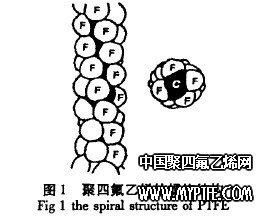PTFE is abbreviated as PTFE. It is a perfluorinated polymer obtained by radical polymerization of tetrafluoroethylene monomer. Its structural formula is  . It was 1938 by American R. Invented by Plunkett. In its molecular structure, carbon atoms are surrounded by four fluorine atoms. Since the covalent radius of the fluorine atom (0.064 nm) is larger than the radius of the hydrogen atom (0.028 nm), the fluorine atoms can be arranged to surround the carbon chain. The fluorine atoms repel each other, so that the entire macromolecular chain is not like a sawtooth like hydrocarbon chain, but spiral structure. As shown in Figure 1, similar to the human DNA helix, the spiral conformation is just surrounded by PTFE vulnerable to chemical attack. Outside of the carbon chain skeleton, a tight and completely "fluorinated" protective layer is formed, so that the PTFE main chain is not attacked by any external agents, so that the PTFE has unmatched solvent resistance, chemical stability and low in other materials. Cohesion energy density. The spiral structure determines the chemical resistance of PTFE.
. It was 1938 by American R. Invented by Plunkett. In its molecular structure, carbon atoms are surrounded by four fluorine atoms. Since the covalent radius of the fluorine atom (0.064 nm) is larger than the radius of the hydrogen atom (0.028 nm), the fluorine atoms can be arranged to surround the carbon chain. The fluorine atoms repel each other, so that the entire macromolecular chain is not like a sawtooth like hydrocarbon chain, but spiral structure. As shown in Figure 1, similar to the human DNA helix, the spiral conformation is just surrounded by PTFE vulnerable to chemical attack. Outside of the carbon chain skeleton, a tight and completely "fluorinated" protective layer is formed, so that the PTFE main chain is not attacked by any external agents, so that the PTFE has unmatched solvent resistance, chemical stability and low in other materials. Cohesion energy density. The spiral structure determines the chemical resistance of PTFE.

PTFE spiral structure
PTFE is a fluorocarbon chemical with excellent chemical resistance and high and low temperature resistance. It will not degrade even when exposed to air and can be used in the range of -200 to 250°C for a long period of time. Due to the influence of electron-withdrawing groups containing fluorine atoms in the molecular structure, PTFE exhibits a high degree of chemical stability and is almost resistant to intrusion of all chemical substances such as acids and bases, outstanding non-stickiness, abnormal lubricity, and excellent electrical insulating properties, and resistance to aging. Sex and radiation resistance, minimal water absorption and other characteristics are known as "plastic king." Widely used in aerospace, petrochemical, machinery, electronics, electrical appliances, construction, textile and many other fields. Because of these characteristics, it was secretly applied to the military industry as soon as it appeared, and it was not applied to static seals until the 1950s. Compared with the general spiral seals, it was a very good elastic seal material.